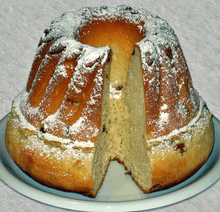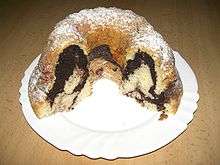Gugelhupf
 | |
| Alternative names | Gugelhopf, Guglhupf, Kugelhopf |
|---|---|
| Type | Bundt cake |
| Place of origin | Germany, Austria, Switzerland and Alsace |
| Main ingredients | Yeast dough with raisins, almonds and Kirschwasser |
|
| |
A Gugelhupf, Guglhupf or Gugelhopf is a southern German, Austrian, Swiss and Alsatian marble cake or Bundt cake. Gugel- is supposedly a variation of the Middle High German gugel ('hood'), while -hupf is a variation of Hefe ('yeast'). Popular etymology says that the -hupf part comes from the German word hüpfen (to jump), as the yeast dough literally "jumps out of" the cake pan.
It is spelled kuglóf in Hungarian, kuglof (Cyrillic: куглоф) in Serbo-Croatian and Macedonian, Kugelhopf in Alsatian, kouglof in French and guguluf in Romanian. In Western Slovenia, it is also known as kuglof, and in Central and Eastern Slovenia, kugluh.
In Upper Austria it is known as Wacker or Wacka. It is called bábovka in Czech and Slovak, and babka in Polish. In Slovenia, the standard word is šarkelj.
The pastry

Gugelhupf is a big cake and has a distinctive ring shape or the shape of a torus. It is usually eaten with coffee, at coffee breaks.
Gugelhupf consists of a soft yeast dough which contains raisins, almonds and Kirschwasser cherry brandy. Some also contain candied fruits and nuts. Some regional varieties (Czech, Hungarian and Slovak) are also filled, often with a layer of sweetened ground poppy seeds.
It is baked in a special circular pan with a central tube, originally made of enamelled pottery. Similar pans are used for making Bundt cakes, a cake baking pan shape in the US derived from the Gugelhupf.
The Gugelhupf was the sweet chosen to represent Austria in the Café Europe initiative of the Austrian presidency of the European Union, on Europe Day 2006.
See also
External links
-
 Media related to Gugelhupf at Wikimedia Commons
Media related to Gugelhupf at Wikimedia Commons -
 Kouglof at Wikibooks
Kouglof at Wikibooks - Sample recipe
- Picture of a Marmorgugelhupf
